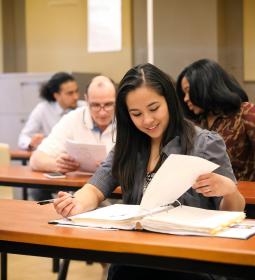Today, education has become a race: faster, bigger, harder. Parents worry about whether the child is keeping up with the program, and children from the first years of school feel that something is required of them. In this rhythm, it is easy to forget that learning is not a mechanical memorization of formulas and rules, but a living process in which the child discovers the world and himself.
There are schools where this is understood, where knowledge is not imposed, but helps to live. One of these schools is the Waldorf school.
How it all began
The first Waldorf school was opened in 1919 in Stuttgart, Germany. The initiator was the Austrian philosopher Rudolf Steiner, and the project was financed by the Waldorf-Astoria tobacco factory, hence the name.
But the very idea of Waldorf pedagogy was not born by chance. Steiner developed a whole philosophy, anthroposophy, which considered man not only as a rational being, but also as spiritual, emotional, and volitional. He believed that learning should take into account all these aspects, and not be reduced to the mechanical assimilation of information.
Today, there are hundreds of Waldorf schools around the world. These are not elite educational institutions for a select few, but schools for those who are looking for an alternative to the standard education system.
The main principle is that a child is not a vessel to be filled, but a personality to be revealed.

In ordinary schools, the main goal is to provide knowledge. In Waldorf, it is to develop a holistic personality. Here the child is considered as a creature who has a body, a soul and a spirit, and each of these aspects develops according to its own laws.
For example, before the age of seven, it is important that the child learns about the world through play and action, and not through abstract symbols. Therefore, there are no textbooks in the younger grades, but there is a lot of creativity, needlework, movement. From 7 to 14 years old is a period when it is important to connect emotions and experiences. History is studied here not through dates and terms, but through stories, images, dramatizations. Only after the age of 14 does the stage of conscious thinking begin, and then the teenager is ready for analysis, logic, and a scientific approach.
How do they teach?
The teaching methods at the Waldorf School are very different from the usual ones.
Not just to explain, but to live
In a standard school, the teacher gives a definition: "A noun is a part of speech that denotes an object." Children write down, do exercises, and forget.
In the Waldorf school, everything is different. The teacher invites children to write a story using only words that denote objects. Then together they analyze what these words are, how they differ from others. Gradually, the children themselves come to the conclusion: "Well, these are nouns!" and then the rule is written down. But it is no longer abstract – the child himself deduced it, lived through experience.
Learning is practice, not cramming
Physics at the Waldorf School begins not with formulas, but with observations. To understand the sound, children listen to how the violin string sounds, and try to reproduce different sounds themselves. Studying light, they watch how the ray is refracted through a prism. This is not just entertainment - this is how the brain assimilates knowledge deeper.

No narrow specialization
In ordinary schools, in grades 10-11, there is a profile division: someone goes to mathematics, someone to the humanities. In the Waldorf school, until the end of their studies, children are engaged in everything: needlework, music, painting, gardening. They try themselves in different fields, giving them flexibility of thinking and the ability to adapt.
What about grades?
There is no system of fives and threes. Because a mark is an external stimulus, and the task of the school is to develop internal motivation. But this does not mean that there is no feedback in the Waldorf school.
Teachers analyze the work of each child in detail, write characteristics, and conduct personal conversations. The student understands what to work on, but without fear of getting a "two".
In high school, if the school is accredited, grades still appear - you need to get used to them before passing the OGE and USE.
How are the lessons held?
Regular schools follow a standard schedule: today there are 45 minutes of mathematics, then history, then physical education. In the Waldorf system, there is a different approach: learning takes place in blocks (they are called "epochs").
For example, for three weeks, children study only geometry. They are completely immersed in the topic, try to draw complex shapes, find geometric shapes in architecture, art, and nature. Then the object is changed. This format helps to better assimilate the material and not to spread yourself too thin.
But this does not mean that everything else is forgotten for a while! In addition to the main block, there are regular classes in music, drawing, and physical education.
A teacher is not just a teacher, but a mentor
In the Waldorf school, from grades 1 to 8, the same teacher works with children. This is not just a teacher, but a person who leads the class, knows each child, his strengths and weaknesses.

To teach in such a school, it is not enough to have a diploma: you need to undergo special preparation, study the philosophy of Waldorf pedagogy, and understand the age characteristics of children.
What about graduates?
There is a myth that children from Waldorf schools cannot enter universities because they have a "non-standard" education. In practice, this is not the case. Graduates take the Unified State Exam, enter universities, many choose creative professions or sciences related to manual work (architecture, medicine, design, engineering).
But the main thing is that they leave school not just with a set of knowledge, but with the ability to learn, search for information, and make decisions.
Who is this format suitable for?
Waldorf school is not for everyone. It requires internal discipline from the child, respect for the rules, and readiness for independence. If the child is used to the fact that he needs to be forced to study, it will be difficult for him here.
But if he is open to new things, loves to create, ask questions, if parents are ready to trust the school and not require reports with grades every week, this format can be a great alternative to standard education.
Why is this important?
The world is changing, but the education system remains the same. The Waldorf School is an attempt to make learning lively, not formal. Here, knowledge becomes not a goal, but a tool for understanding the world. Perhaps, it is this approach that will help raise a generation of people who know how to think, feel and find their place in life.













